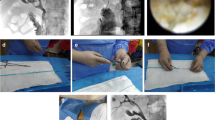Abstract.
Abstract.
Purpose:
Endoscopic bile duct clearance is now the treatment of first choice for bile duct stones, particularly in elderly or high-risk patients. The purpose of this study was to objectively assess the safety, efficiency, and ease of use of percutaneous transhepatic choledochoscopy, using a small-caliber choledochoscope with a facilitated insertion technique, in high-risk elderly patients with choledocholithiasis.
Methods:
Sixty-five consecutive patients with common bile duct stones scheduled for percutaneous transhepatic choledochoscopic lithotomy were studied prospectively. Choledochoscopy was carried out with a simplified introducer system, using a 2.8-mm choledochoscope with electrohydraulic lithotripsy.
Results:
The common bile duct was successfully accessed and the stones removed in all 65 patients. The average time for the entire procedure was 45 min. There were no serious procedure-related complications.
Conclusions:
Percutaneous transhepatic choledochoscopic lithotomy, using electrohydraulic lithotripsy, is an attractive alternative for patients with common bile duct stones when surgery or retrograde methods are not suitable.
Similar content being viewed by others
Author information
Authors and Affiliations
Additional information
Received: February 27, 2001 / Accepted: May 11, 2001
About this article
Cite this article
Ogawa, K., Ohkubo, H., Abe, W. et al. Percutaneous transhepatic small-caliber choledochoscopic lithotomy: a safe and effective technique for percutaneous transhepatic common bile duct exploration in high-risk elderly patients. J Hep Bil Pancr Surg 9, 213–217 (2002). https://doi.org/10.1007/s005340200021
Issue Date:
DOI: https://doi.org/10.1007/s005340200021




